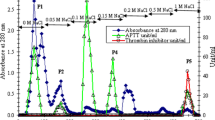Summary
An anticlotting factor was found recently in the cephalothoracic latero-oesophageal glands (G.L.O.) of Cymothoid Isopods (blood-sucking fishparasites). This substance is efficient on the blood of hosts such as Boops boops (L.), and also on the human plasma.
The way of action and the chemical kind of this factor were investigated:
Plasmatic coagulation-tests (Howell, Quick, Cephalin-kaolin, Stypven, Stypven-cephalin, Thrombin and Thrombin coagulase times) were realized on citrated plasmas of Boops and man;
enzymatic activities of latero-oesophageal glands and hepatopancreas of Meinertia oestroides (Risso, 1826) were also studied.
Our results show that the anticlotting action of G.L.O. extracts proceeds from an anti-thrombinic factor, certainly carbohydrate-like as heparin.
Résumé
Un facteur anticoagulant a été récemment mis en évidence au niveau des glandes céphalothoraciques latéro-oesophagiennes (G.L.O.) des Isopodes Cymothoidae (parasites hématophages de poissons). Cette substance est active sur le sang des hôtes tels que Boops boops (L.), mais aussi sur le plasma humain.
Afin d'essayer de déterminer le mode d'action et la nature chimique de ce facteur.
des tests de coagulation plasmatiques (temps de Howell, de Quick, de Céphaline-kaolin, de Stypven, de Stypven-céphaline, de Thrombine et de Thrombine coagulase) ont été effectués sur des plasmas de Bogues et sur des plasmas humains citratés;
des études d'activités enzymatiques ont été envisagées au niveau des glandes latéro-oesophagiennes et de l'hépatopancréas de Meinertia oestroides (Risso, 1826).
Les résultats obtenus permettent de préciser que l'action anticoagulante des extraits de G.L.O. est due à un facteur antithrombinique, certainement de nature glucidique comme l'héparine.
Similar content being viewed by others
Références
Eiff, J.A.: Nature of an anticoagulant from the cephalic glands of Ancylostoma caninum. J. Parasit. 52, 833–843 (1966)
Fain-Maurel, M.: Contribution à l'histologie et à la caryologie de quelques Isopodes. Spermiogenèse et infrastructure du spermatozoïde des Oniscidés et des Cymothoidés — Acquisitions récentes sur les spermatogenèse atypiques. Thèse d'Etat, Université Paris, série A No 4468, No d'ordre 5316 (1966)
Gabe, M.: Données histochimiques sur les glandes exocrines céphalothoraciques d'Anilocra physodes Leach. Ann. Histochim. 5, 55–63 (1966)
Hoeppli, R., Feng, L.C.: The presence of an anticoagulin in the esophagus of Bunostomum trigonocephalum from the intestine of sheep. Arch. Schiffs- u. Tropenhyg. 37, 176–182 (1933)
Loeb, L., Fleischer, M.S.: The influence of extracts of Ancylostoma caninum on the coagulation of the blood and on hemolysis. J. infect. Dis. 7, 625–631 (1910)
Loeb, L., Smith, A.J.: The presence of a substance inhibiting the coagulation of blood in Ancylostoma. Proc. path. Soc. Philad. 7, 173–178 (1904)
Loeb, L., Smith, A.J.: Über eine die Blutgerinnung hemmende Substanz in Ancylostoma caninum. Zbl. Bakt., 1. Abt. Orig. 37, 93–98 (1904a)
Markwardt, F., Walsmann, P.: Die Reaktion zwischen Hirudin und Thrombin. Hoppe-Seylers Z. physiol. Chem. 312, 85–98 (1958)
Romestand, B., Trilles, J.-P.: Production d'une substance anticoagulante par les glandes exocrines céphalothoraciques des Isopodes Cymothoidae Meinertia oestroides (Risso, 1826) et Anilocra physodes (L., 1758) (Isopoda, Flabellifera, Cymothoidae). C.R. Acad. Sci. (Paris) 1976 (sous presse)
Schwartz, B.: Effect of secretions of certain parasitic nematodes on coagulation of blood. J. Parasit. 7, 144–150 (1921)
Thorson, R.E., The effect of extracts of the amphidial glands, excretory glands, and esophagus of adults of Ancylostoma caninum on the coagulation of dog's blood. J. Parasit. 42, 26–30 (1956)
Trilles, J.-P.: Recherches sur les Isopodes Cymothoidae des côtes françaises. 1 ère Thèse: Bionomie — Parasitisme — Biologie générale — Sexualité. Thèse d'Etat, Université Montpellier, No AO 2305 (1968)
Weinberg, M.: Sur une hémotoxine d'origine vermineuse. C.R. Soc. Biol. (Paris) 63, 13–15 (1907)
Author information
Authors and Affiliations
Rights and permissions
About this article
Cite this article
Romestand, B., Trilles, J.P. Au sujet d'Une substance à activité antithrombinique mise en évidence dans les glandes latéro-oesophagiennes de Meinertia oestroides (Risso, 1826) (Isopoda, Flabellifera, Cymothoidae; parasite de poissons). Z. F. Parasitenkunde 50, 87–92 (1976). https://doi.org/10.1007/BF00389936
Received:
Issue Date:
DOI: https://doi.org/10.1007/BF00389936




